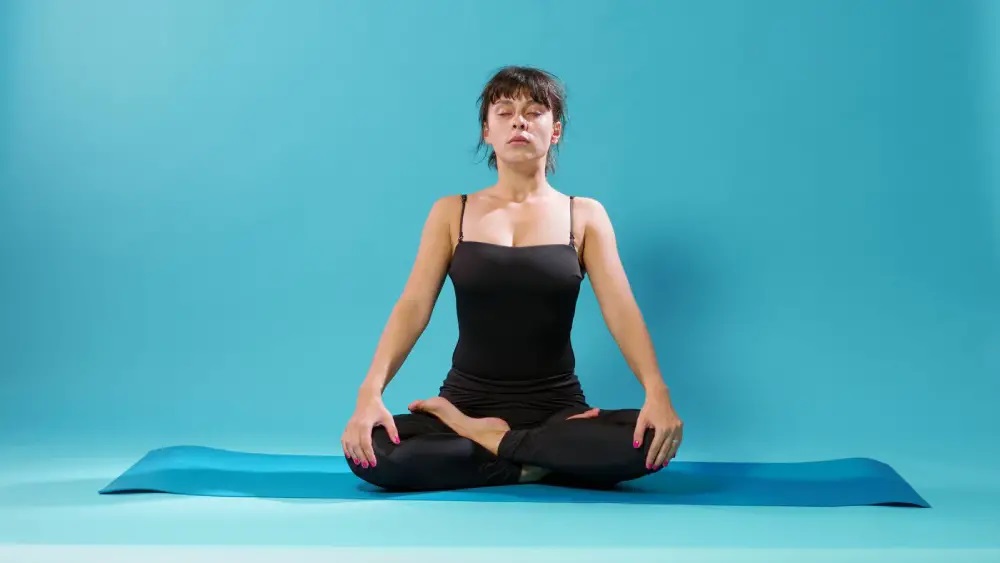Yoga seems to be low maintenance and relaxing, so dizziness can come as a surprise. Here are the reasons why you get dizzy after yoga.
Yoga causes many feelings and emotions: your body relaxing, muscles stretching, the mind-clearing. It’s no secret that an intense yoga session can leave you feeling like you’ve just had a good workout, but it shouldn’t leave you feeling like the world is spinning around you.
In fact, being dizzy after yoga can indicate a couple of potential problems, and understanding the root of the issue will help you get back to enjoying the good energy that comes from a proper yoga session. Some common causes of dizziness after yoga include issues with deep breathing, dehydration, sodium intake, and more.
Let’s take a closer look at these causes, and decipher why you feel as if you’re crashing to the ground when you should be feeling on top of the world.
Contents
1. Breathing

Breathing is a big part of yoga— but the slow and deep breathing techniques used in yoga can be an issue when it comes to dizziness. When we use deep breathing, we tend to breathe out a lot of carbon dioxide, making it tough for our bodies to keep up. Breathing out CO2 faster than our bodies can produce causes our blood vessels to constrict, limiting and slowing the oxygen from traveling to different places — such as our brain.
This constriction of blood vessels and imbalance between oxygen and carbon dioxide can cause light-headedness or dizziness — think of when you hyperventilate. Your CO2 levels drop rapidly, and you may consequently get dizzy. Although you’re not breathing in and out quickly with deep breathing, you’re still expelling a large amount of CO2 in one long exhale.
2. Dehydration
One of the biggest causes of feeling dizzy after yoga, or in general, is dehydration. Showing up to your yoga class after a day of poor hydration can cause your body to panic, especially considering that you are about to take part in physical activity.
On top of that, yoga can make you sweat. That is especially true with different types of yoga — think of hot yoga, for example. Sweating out fluid while already dehydrated is a recipe for disaster.
The body can only sacrifice so much water before it needs to shut down other processes.
Essentially, sweating is a cooling mechanism the body uses — sweat evaporates off your skin, taking some heat with it. This mechanism allows your body’s core temperature to stay regulated, saving you from heat stroke and other nasty problems.
The body is smart: if it doesn’t get what it needs from the main source, it will take resources from other areas. In theory, this works great and is essential in survival situations. However, yoga shouldn’t put us in a do-or-die survival situation — preferably, nothing you experience will!
Your body will start to constrict your blood vessels and decrease the amount of flow different parts of your body get in order to try and navigate the heat away from the core and shut down the areas that are creating the most heat, like your muscles.
This is where you see people breathing hard and going grey in the face — and, if they’re really unlucky, fainting. Dizziness is an early sign that we don’t have enough water in our system, and our body is trying to warn us that we need to get some. You might enjoy our explainer on can you drink tea before yoga.
3. Quick Transitions
I wouldn’t be able to tell you my favorite yoga position because what I really love is the flow of it all. Moving from one position to the next, creating a story between movements, and fusing the spirit and body into one is the art that I fell in love with. That being said, moving too quickly from one position to the next can cause dizziness.
Look at it this way: there is probably a time in your life that you can remember when you got up from a chair or a bed too fast and started seeing black dots while your room started swaying. This quick transition from one position to the next can cause a sharp change in blood pressure, in a condition called orthostatic hypotension.
When you are in a horizontal position for an extended period and quickly move to a more upright position, you don’t give the blood that has pooled in your upper body and arms a chance to fill your lower body again.
Instead, this blood quickly rushes out of your upper body and into your lower body, causing a temporary drop in the amount of blood in the upper body, leaving the heart with less to pump. This creates decreased blood pressure, which is characterized by light-headedness.
4. Head Rush

Similarly to the last cause we just talked about, certain yoga positions like Sirsasana, Downward-Facing Dog, and the Dolphin Pose can cause blood to rush into your brain, causing a change in blood pressure.
Usually, this isn’t a big deal, but if you’re down there for a while, that prolonged pressure can cause irritation to the structures dealing with balance, causing you some dizziness — especially after moving upright again.
5. Decreased Sodium Intake
Sodium intake refers to the amount of salt you get in your diet. On average, people in the Western world consume too much salt in fast-food and other processed foods. However, as an active yoga enthusiast, you need to have enough salt in your system.
The thing is, salt is an electrolyte, which are essential minerals that help the body function and stay hydrated by holding water. Without enough electrolytes, your muscles are more likely to cramp and get fatigued — and you’re also more likely to experience dizziness.
We lose electrolytes through sweating and urinating, so it’s important to keep a balanced sodium intake along with a high water intake! You might also be wondering if should you drink a protein shake after yoga.
FAQs On Dizziness After Yoga
What should you eat to prevent dizziness after yoga?
Try your best to eat a well-balanced diet that consists of healthy fats, proteins, carbohydrates, and sodium. A couple of food examples are:
1. Avocados
2. Nuts
3. Bananas
4. Beans
5. Milk
How much water should you drink before yoga?
You want to drink about two to three liters of water every day to stay hydrated and keep your muscles and blood pressure functioning well in order to minimize any chances of becoming dizzy due to dehydration.
What Can You Do In A Yoga Class To Prevent Dizziness?
We want to look at what positions are causing increased pressure in your head due to blood flow or any position changes that take you from horizontal to vertical in a short amount of time. Once we’ve pinpointed where those dizzy spells happen, we can more effectively modify the positions and be more intentional about slowing down our transitions. Your yoga instructor should have some good pointers for each pose or transition.
Also, focus on breathing — try to keep your inhales as long as your exhales, matching the two to offset the imbalances between CO2 and oxygen in your blood. Modifying some of those aggravating positions and staying controlled with your movements and breathing speed can do wonders for any dizzy spells, leaving you feeling stable and ready for your next session!



